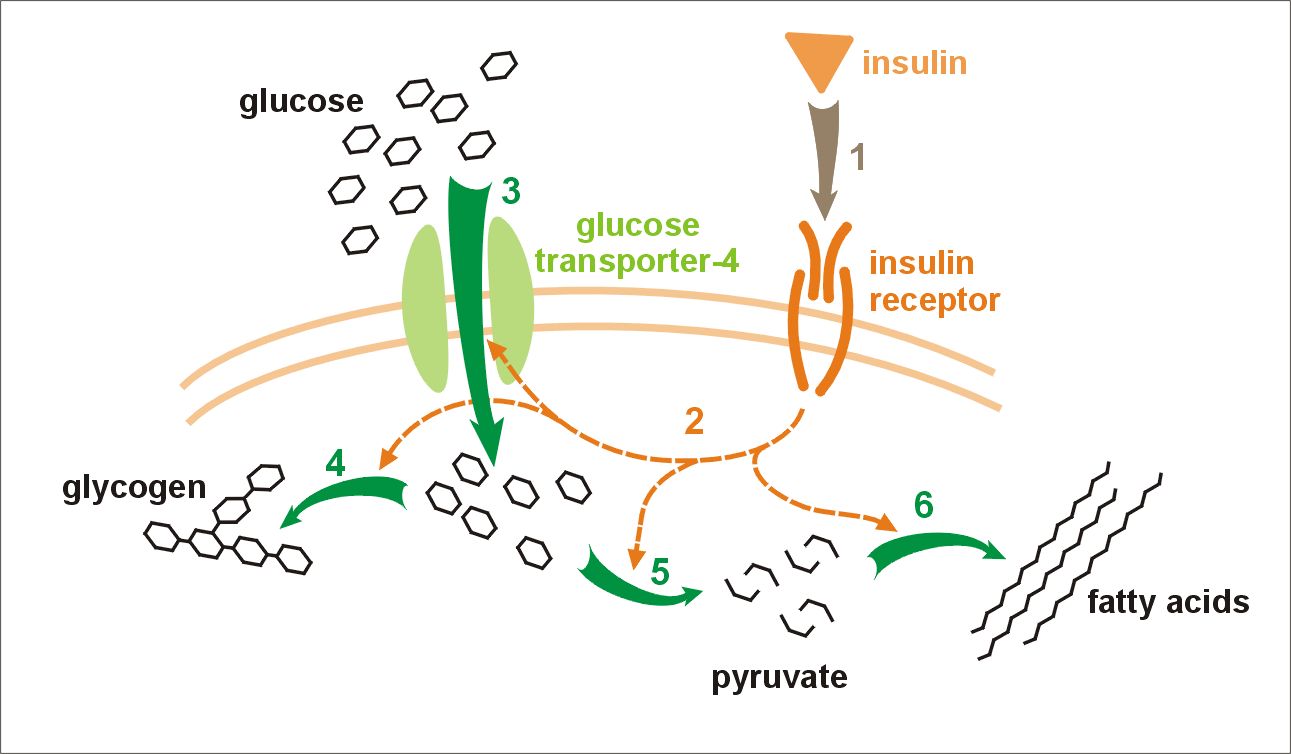In the second chapter, we focused on fuel metabolism-- how our bodies use certain molecules and biochemical pathways to maintain its energy demands. Our bodies go through 3 stages of taking in energy from the food we eat. In the first stage, large molecules are broken down into smaller ones. [Proteins> amino acids, Polysaccharides>Monosaccharides, Fats> Glycerol/ Fatty Acids] In stage 2, those smaller molecules are turned into Acetyl CoA. In the third stage, our body engages in oxidation of fuel molecules through the Krebs Cycle and ETC (Electron Transport Chain) to create ATP. In the Fed State, glucose in absorbed by intestines into the liver. Simultaneously, the pancreas releases insulin and converts it into glycogen. Excess amino acids are sent to the liver for processing while excess glucose and fatty acids are converted to triglycerides and stored as fat. In the Fasting State, insulin levels drop and glucagon levels rise. Glucogenesis occurs where the liver creates new glucose from amino acids and glycerol. Fatty acids are used by the heart and muscle tissue and glucose is saved for the brain. When carbohydtrate levels are low, the liver converts excess Acetyl CoA into ketone bodies for the Krebs Cycle. When the body reaches the starvation state, the body relies on adipose tissue for energy and the brain relies on ketone bodies for fuel. The Cori Cycle occurs during exercise when lactic acid is released into the blood and liver converts glucose into glucogenesis. Insulin signals high glucose levels and glucagon signals low glucose levels.
In our third chapter, we learned about diabetes and how it is a disruption to fuel metabolism. Our bodies have insulin to unlock our cells and allowing glucose to enter. When this cycle is disrupted, our bodies become insulin dependent, GLUT-4 transportation is transported into muscle and fat cells. Exercise increases the production of GLUT-4 without having to increase insulin levels, which is why diabetics are encouraged to exercise more since their bodies don have normal levels of insulin. Diabetes occurs when our body cannot properly regulate blood glucose levels. Type 1 Diabetes is hereditary, meaning it is inherited by family members and the body is unable to produce insulin, often requiring patients to take insulin shots. Type 2 Diabetes occurs when our cells no longer listen"to the insulin message and produces too much insulin. It can be prevented by frequent exercise and a healthy lifestyle.
In the fourth chapter, we learned about the Endocrine System and how the glands use hormones to control various activities in our body. We have two different types of hormones: steroid hormones and nonsteroid hormones. Steriod hormones are lip soluble and diffuse through cell membranes, while nonsteroid hormones are not lipid soluble and receive receptors externally through the cell membrane. The steroid hormones do this by entering the nucleus to bind the DNA-- activating certain genes. When nonsteroid hormones react with receptors externally, an enzyme reaction occurs that triggers the development of cAMP. Negative feedback is a mechanism our body uses to maintain homeostasis. Our posterior lobe contains ADH which is in charge of fluid retention, while the anterior lobe is a growth hormone that signals puberty. The thyroid gland regulates metabolism and increases protein synthesis, and the parathyroid glands secrete hormones for plasma calcium and phosphate levels regulation. Our fight or flight respose is initiated by epinephrine, while norepinephrine is our "house keeping system." The adrenal cortex is reponsible for secreting 30 different steroids hormones like aldosterone and cortisol. Our pancreas regulates glucose transport, the gonads are our sex hormones, and the kidneys regulate the production of red blood cells.
What I found most successful for me was the supplemental articles we read that went along with our unit. They helped me gain a deeper understanding of the topics through the lens of an author who had their own personal research and discoveries. I found the "Does your Metabolism Need an Overhaul" to be most interesting as it addressed the problem of unused muscle fivers that will negatively affect you health in the future. I learned that it is important to engage in resistance training because sugar is burned in muscle tissue. Resistance training allows your muscles to create a perma-burn which consumes sugar whether you are exercising or just sitting on your couch.
The most challenging aspect of this unit was fully understanding the specific cycles and roles of organs within each chapter. I will need to review fuel metabolism and the chemical sequences behind each state. Although I grasp the big picture of each chapter, I need to refine my understanding of the details of each section and make sure I am certain about that information when entering the test. One of my main goals set in this new year was to be 110% ready going into an exam. I do not want to feel stressed because I did not study, but rather know that I had exerted my fullest potential before and after the exam. Click here to read more about my New Year Goals. I want to learn more about the specific ways people can prevent getting Type 2 Diabetes. Since many cases begin with pre-diabetic patients, what kinds of lifestyles will help to avoid contracting diabetes for those who have a family history or are considered pre-diabetic. Are there specific diets/exercise methods people have tried that successfully prevented diabetes?





No comments:
Post a Comment